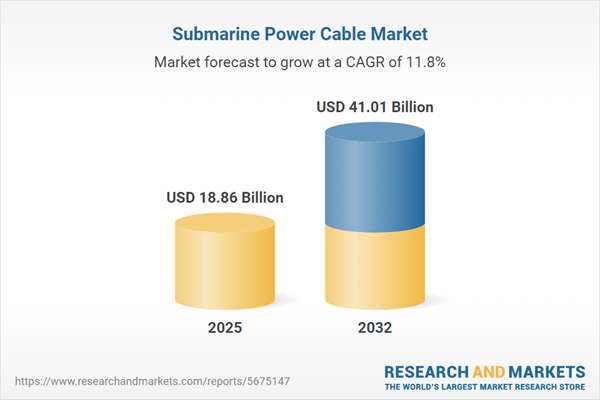Speak directly to the analyst to clarify any post sales queries you may have.
The submarine power cable market is transforming the backbone of global energy and telecom networks by enabling greater resilience, expanded capacity, and advanced connectivity for organizations across diverse regions and industries. As strategic infrastructure evolves in response to digitalization and regulatory shifts, these solutions are increasingly pivotal for supporting modernization goals and sustaining competitive advantage.
Market Snapshot: Submarine Power Cable Market Growth
In 2024, the submarine power cable market reached USD 16.85 billion, driven by an annual 11.75% CAGR. This robust expansion reflects the sector’s growing role in advancing offshore renewable projects, strengthening interregional grid connections, and satisfying rapidly rising demands for subsea communications. Investments are focusing on innovative cable systems that increase energy transfer capabilities and support the rollout of secure, high-capacity digital networks. Regulatory changes paired with heightened sustainability requirements are shaping the direction and pace of demand for advanced, resilient subsea infrastructure, influencing business strategies on a global scale.
Scope & Segmentation of the Submarine Power Cable Market
- Application: Supports seamless integration of regional and international power grids, underpins high-volume telecom links, and is fundamental to digital transformation initiatives.
- Voltage Level: Offers a spectrum of extra high, high, and medium voltage solutions tailored for long-range energy transmission, regional grid enhancement, and renewable energy connectivity.
- Insulation: Incorporates ethylene propylene rubber (EPR), cross-linked polyethylene (XLPE), and specialty coatings to ensure durable, long-lasting performance under challenging marine conditions.
- Conductor Material: Utilizes lightweight aluminum in cost-sensitive projects and premium copper where superior flexibility and durability are required.
- Installation Method: Deploys horizontal directional drilling and water jetting for near-shore applications, complemented by specialized vessels and remotely operated vehicles (ROVs) for deepwater and offshore installation.
- Regional Coverage: Spans the Americas, Europe, Middle East, Africa, and Asia-Pacific, with each region focusing on its own set of priorities: renewable energy for Asia-Pacific, regulatory standardization in Europe, and grid enhancements across the Americas.
- Major Companies: Prysmian S.p.A., Nexans S.A., NKT A/S, LS Cable & System Ltd., Sumitomo Electric Industries, Furukawa Electric Co., Huanqiu Cable, Jiangsu Zhongtian Technology, ABB Ltd., and JDR Cable Systems—these organizations set industry benchmarks for innovation and supply reliability.
Key Takeaways for Senior Decision-Makers
- Continuous advancement in insulation and conductor technologies is leading to longer service life and improved durability, limiting maintenance needs and reducing asset risk in marine environments.
- Simplified permitting and updated regulatory processes are supporting more efficient project development and help organizations adjust infrastructure investments in response to changing industry demands.
- Collaboration between developers, suppliers, and contractors is crucial for managing project risk, ensuring consistent quality, and solving location-specific challenges across global deployments.
- The adoption of digital tools for real-time monitoring and predictive maintenance allows for better oversight and proactive management of mission-critical submarine cable assets.
- Regional trends influence market adoption—Asia-Pacific is notable for renewable energy integration, Europe for regulatory adaptation, and the Americas and Middle East/Africa for modernization and resilience projects.
Tariff Impact: United States Policy Measures and Global Supply Chain
Recent U.S. tariff changes have introduced new complexities into sourcing raw materials such as copper and insulation for submarine power cables. To counteract supply chain disruptions, market leaders are ramping up domestic manufacturing, establishing international supply partnerships, and streamlining logistics. Maintaining collaborative ties with key suppliers in Asia and Europe remains essential for on-time project execution and long-term resilience in the face of evolving trade and policy environments.
Methodology & Data Sources
This analysis is based on structured conversations with sector leaders, thorough technical document reviews, and scrutiny of market and patent databases. Only validated, high-integrity data is included to guide executive decisions regarding infrastructure planning and operational strategy.
Why This Report Matters
- Enables leaders to identify new market opportunities and align investment approaches with current trends in the submarine power cable sector.
- Strengthens procurement processes and supports regulatory compliance and digitalization, helping organizations perform efficiently across international markets.
- Delivers strategic, actionable insights to support efforts in future-proofing infrastructure for sustainability and emerging technical standards.
Conclusion
Long-term success in the submarine power cable market relies on a commitment to technical innovation, agile supply chain management, and regulatory adaptability. This report arms decision-makers with the intelligence required for robust planning and resilient infrastructure investment.
Additional Product Information:
- Purchase of this report includes 1 year online access with quarterly updates.
- This report can be updated on request. Please contact our Customer Experience team using the Ask a Question widget on our website.
Table of Contents
3. Executive Summary
4. Market Overview
7. Cumulative Impact of Artificial Intelligence 2025
Companies Mentioned
The companies profiled in this Submarine Power Cable market report include:- Prysmian S.p.A.
- Nexans S.A.
- NKT A/S
- LS Cable & System Ltd.
- Sumitomo Electric Industries, Ltd.
- Furukawa Electric Co., Ltd.
- Huanqiu Cable Co., Ltd.
- Jiangsu Zhongtian Technology Co., Ltd.
- ABB Ltd.
- JDR Cable Systems Limited
Table Information
| Report Attribute | Details |
|---|---|
| No. of Pages | 199 |
| Published | October 2025 |
| Forecast Period | 2025 - 2032 |
| Estimated Market Value ( USD | $ 18.86 Billion |
| Forecasted Market Value ( USD | $ 41.01 Billion |
| Compound Annual Growth Rate | 11.7% |
| Regions Covered | Global |
| No. of Companies Mentioned | 11 |









